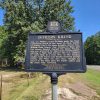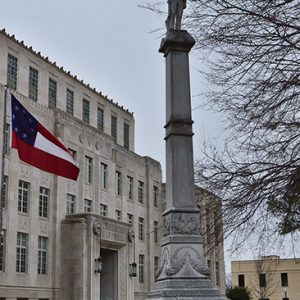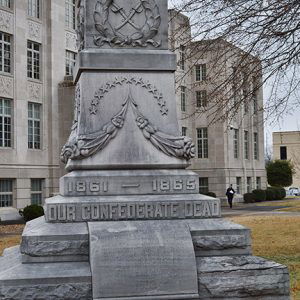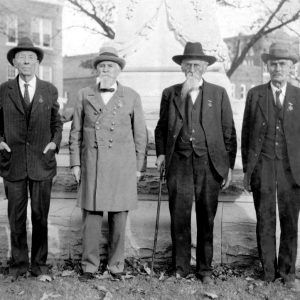calsfoundation@cals.org
Fort Smith Confederate Monument
The Fort Smith Confederate Monument is a sculpture erected in 1903 at the Sebastian County Courthouse in Fort Smith (Sebastian County) by the Varina Jefferson Davis Chapter of the United Daughters of the Confederacy (UDC) to commemorate local men who served in the Confederate army during the Civil War and to honor the Confederates buried in Fort Smith National Cemetery.
Sebastian County supplied troops for both sides during the Civil War. In the initial months of the war, four infantry companies, a cavalry company, and an artillery battery joined the Arkansas State Troops, and at least five infantry companies and two companies of independent scouts were later raised for Confederate service. Sebastian County residents also enlisted in other Confederate units.
U.S. troops abandoned the army base at Fort Smith at the start of the Civil War, and Confederate forces occupied the base from April 23, 1861, to August 31, 1863. During the occupation, Confederate forces buried casualties of disease and battle in the post cemetery, which in 1867 was designated as the Fort Smith National Cemetery. As many as 473 Confederates are buried there, including brigadier generals James McQueen McIntosh and Alexander Steen. Around 1875, former general James Fagan and local Confederate veteran Dr. Elias Duval began an effort to place a memorial in the cemetery to recognize the generals and other Confederate casualties, a project enthusiastically supported by the women of Fort Smith. “A modest, yet appropriate shaft” was installed, but it was destroyed by a tornado on January 11, 1898.
On October 9, 1898, the Varina Jefferson Davis Chapter of the United Daughters of the Confederacy formed, planning “to fulfill the duties of sacred charity toward monuments to our dead,” and began raising funds for a replacement monument. The chapter raised $936.64 “by giving teas, dances and suppers, attending booths at street fairs and various entertainments.” A committee of two UDC members solicited another $1,196, and the Ben T. Duval Camp of United Confederate Veterans raised $199.75.
Using that $2,332.39, the Davis chapter proposed a six-foot marble statue of a Confederate infantryman atop a towering granite shaft. The north face of the monument would be inscribed “LEST WE FORGET / 1861–1865 / OUR CONFEDERATE DEAD / ERECTED / BY THE / VARINA JEFFERSON DAVIS / CHAPTER, DAUGHTERS / OF CONFEDERACY / FORT SMITH, ARK. / 1903.” The shaft also would feature carvings of crossed Confederate flags on the west side, crossed cannons on south, and an anchor on the east face. A carved garland would surround the entire base, embossed with thirteen stars representing the thirteen Confederate states. However, when the design was submitted to the U.S. War Department, Secretary of War Elihu Root refused to accept it for placement in the national cemetery because it featured the Confederate soldier, Confederate flags, and the phrase “Lest We Forget.” When the federal government suggested a new design without those elements, a newspaper reported that “the condition imposed made the Daughters so indignant and so hurt them that they decided to find another site on which could be erected their magnificent tribute to the noble dead of the South.”
In January 1903, the Fort Smith City Council voted to allow the monument to be placed on the grounds of the Sebastian County Courthouse. The dedication was set for September 10, 1903, and Fort Smith mayor Henry Kuper issued a proclamation “respectfully request[ing] that all places of business close between the hours of 2 and 4 o’clock p.m. that all may have the opportunity of attending said exercises.” Trains brought former soldiers to town, and the Fort Smith Times reported that “octogenarians lost the shuffle of age and stepped briskly along the streets with minds quickened and the spirit of ’61 dominant.”
The celebration began with a parade of seventy-five Confederate veterans and Duval Camp members, followed by a marching band, to the courthouse, where the front row of seats was reserved for UDC members, the invited Grand Army of the Republic members, and the former Confederate soldiers. The featured speaker was Senator James Berry, who condemned the federal actions at the national cemetery, thundering “it is our cause, it is our monument, and they are our dead, and we will never permit any man who is not in sympathy with the cause to say what shall be engraved upon it, or write the dedication or epitaph of our dead soldiers.” Daisy Cravens, Jessie McCorkle, and Lona Euper pulled the cord to reveal the monument, and the crowd cheered.
The Fort Smith Confederate Monument was listed on the National Register of Historic Places on April 26, 1996.
For additional information:
Dodson, Mrs. Thomas F. “Confederate Monuments and Markers in Arkansas.” Arkansas Division UDC, 1960.
The Goodspeed Biographical and Historical Memoirs of Northwestern Arkansas. Chicago: Goodspeed Publishing Co., 1889.
Logan, Charles Russell. “Something So Dim It Must Be Holy”: Civil War Commemorative Sculpture in Arkansas, 1886–1934. Little Rock: Arkansas Historic Preservation Program, 1996. Online at https://www.arkansasheritage.com/arkansas-preservation/programs/publications (accessed April 18, 2024).
“Mayor’s Proclamation.” Fort Smith Times, September 9, 1903, p. 8.
“The Monument Unveiling.” Fort Smith Times, September 10, 1903, pp. 1, 4.
National Cemetery Administration, “Federal Stewardship of Confederate Dead.” https://www.cem.va.gov/CEM/publications/NCA_Fed_Stewardship_Confed_Dead.pdf (accessed June 13, 2018).
Pruitt, Luke. “When Truth Won’t Do: Fort Smith, Arkansas, Confederate Monument.” Journal of the Fort Smith Historical Society 42 (April 2018): 35–40.
Saccente, Thomas.”Discussions over Fort Smith Rebel Statue Advance.” Arkansas Democrat-Gazette, July 6, 2020, p. 6B.
———. “Fort Smith Petition Calls for Removal of Confederate Statue.” Arkansas Democrat-Gazette, June 15, 2020, pp. 1B, 3B.
“Senator Berry.” Fort Smith Times, September 11, 1903, pp. 4, 5.
Slater, John. “Fort Smith Confederate Monument.” National Register of Historic Places registration form. On file at Arkansas Historic Preservation Program, Little Rock, Arkansas. Online at https://www.arkansasheritage.com/arkansas-historic-preservation-program (accessed April 18, 2024).
Mark K. Christ
Arkansas Historic Preservation Program










Comments
No comments on this entry yet.